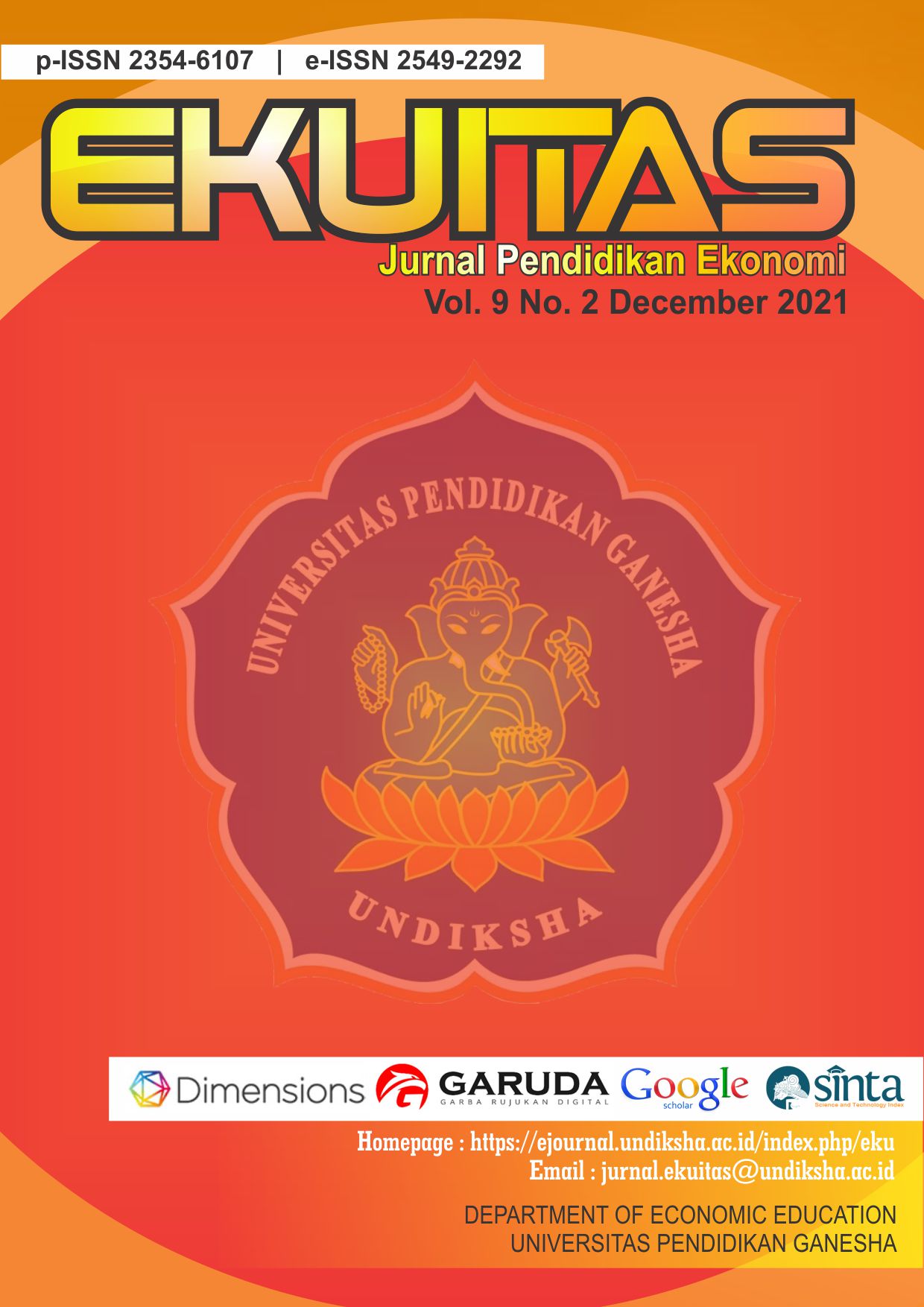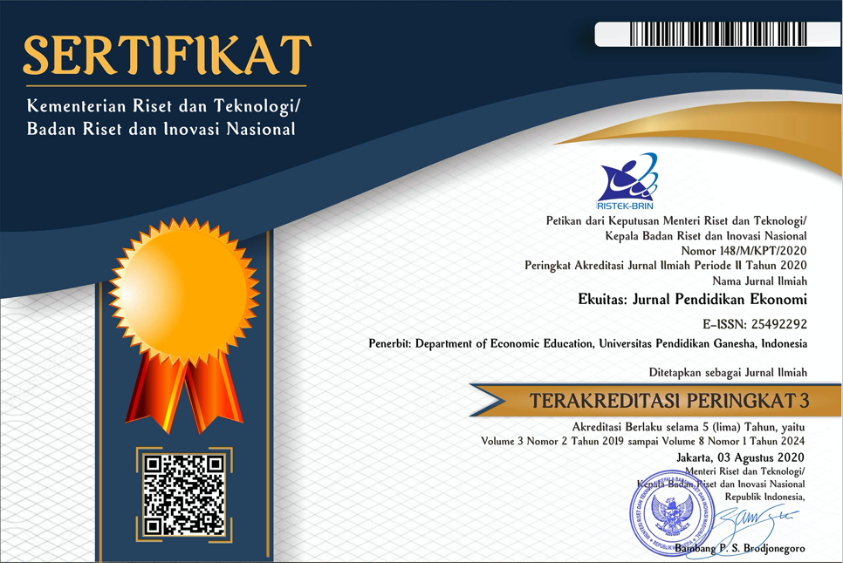Persepsi, Motivasi, dan Kinerja Mahasiswa Akuntansi Syariah atas Pembelajaran Berbasis Kasus
DOI:
https://doi.org/10.23887/ekuitas.v9i2.40639Keywords:
case, learning, sharia accountingAbstract
The development of the sharia financial industry causes universities to prepare their students. The case-based learning is one way to response to the industry's need for human resources with more skills to be ready for work. Therefore, this study aims to measure the effectiveness of case-based learning as measured by the variables of perception, motivation, and performance. Based on the results of experimental tests conducted on 91 students who were divided into two classes, there were no differences in perceptions, motivations, and learning performance between case-based classes and instructional classes. This could be because case-based learning can be more effective in classes with a smaller number of students and for a longer period of time. In addition, the experience of students in receiving and analyzing previous cases is also an obstacle in the effectiveness of case-based learning. This study also found motivation to be a very important variable in increasing perceptions of skill acquisition and learning performance in case-based learning.
References
Ames, C., & Archer, J. (1988). Achievement Goals in the Classroom: Students’ Learning Strategies and Motivation Processes. Journal of Educational Psychology, 80(3), 260–267. https://doi.org/10.1037/0022-0663.80.3.260
Barnes, L. B., Christensen, C. R., & Abby, J. H. (1994). Teaching and the Case Method: Text, Cases, and Readings. Harvard Business Review Press.
Bowe, C. M., Voss, J., & Aretz, H. T. (2009). Case method teaching: An effective approach to integrate the basic and clinical sciences in the preclinical medical curriculum. Medical Teacher, 31(9), 834–841. https://doi.org/10.1080/01421590902922904
Cinneide, B. O. (1997). The role and effectiveness of case studies: student performance in case study vs ‘theory’ examinations. Journal of European Industrial Training, 21(1), 3–13. https://doi.org/https://doi.org/10.1108/03090599710156384
Dahl, D. W., & Smimou, K. (2011). Intrinsic & Extrinsic Motivation_dahl2011.pdf. Managerial Finance, 37(7), 582–609. https://doi.org/http://dx.doi.org/10.1108/03074351111140243
Deci, E. L. (1971). Effects of externally mediated rewards on intrinsic motivation. Journal of Personal Soc. Psychology, 18, 105–115.
Deci, Edward L., Ryan, R. M., Gagné, M., Leone, D. R., Usunov, J., & Kornazheva, B. P. (2001). Need satisfaction, motivation, and well-being in the work organizations of a former eastern bloc country: A cross-cultural study of self-determination. Personality and Social Psychology Bulletin, 27(8), 930–942. https://doi.org/10.1177/0146167201278002
Fordham, A. (1980). Student intrinsic motivation, science teaching practices and student learning. Research in Science Education, 10, 107–117.
Giacalone, D. (2016). Enhancing student learning with case-based teaching and audience response systems in an interdisciplinary Food Science course. Higher Learning Research Communications, 6(3). https://doi.org/10.18870/hlrc.v6i3.304
Golaghaie, F., Asgari, S., Khosravi, S., Ebrahimimonfared, M., Mohtarami, A., & Rafiei, F. (2019). Integrating case-based learning with collective reflection: outcomes of inter-professional continuing education. Reflective Practice, 20(1), 42–55.
https://doi.org/10.1080/14623943.2018.1539660
Grassberger, R., & Wilder, S. (2015). Impacting student learning using a living case study. Higher Education, Skills and Work-Based Learning, 5(4), 369–382. https://doi.org/10.1108/HESWBL-05-2015-0030
Heinrich, C., Pennington, R. R., & Kuiper, R. (2012). Virtual Case Studies in the Classroom Improve Student Knowledge. Clinical Simulation in Nursing, 8(8), e353–e361. https://doi.org/10.1016/j.ecns.2011.02.002
Heitzmann, R. (2008). Case study instruction in teacher education: opportunity to develop students’ critical thinking, school smarts and decision making. Education, 128(4), 523–542.
Hytti, U., Stenholm, P., Heinonen, J., & Seikkula-Leino, J. (2010). Perceived learning outcomes in entrepreneurship education: The impact of student motivation and team behaviour. Education and Training, 52(8), 587–606. https://doi.org/10.1108/00400911011088935
Kardash, C. A. M., & Wallace, M. L. (2001). The perceptions of science classes survey: What undergraduate science reform efforts really need to address. Journal of Educational Psychology, 93(1), 199–210. https://doi.org/10.1037/0022-0663.93.1.199
Ketler, K. (1993). Case-based reasoning: An introduction. Expert Systems With Applications, 6(1), 3–8. https://doi.org/10.1016/0957-4174(93)90014-W
Kim, H. J., Pederson, S., & Baldwin, M. (2012). Improving user satisfaction via a case-enhanced e-learning environment. Education and Training, 54(2–3), 204–218. https://doi.org/10.1108/00400911211210305
Kolodner, J.L., & Leake, D. B. (1996). A tutorial introduction to case-based reasoning. In D. Leake (Ed.), Case-Based Reasoning: Experiences, Lessons and Future Directions (pp. 81–92). AAAI Press. http://www.jimdavies.org/summaries/kolodner1996-2.html
Kolodner, Janet L. (1997). Educational implications of analogy: A view from case-based reasoning. American Psychologist, 52(1), 57–66. https://doi.org/10.1037//0003-066x.52.1.57
Lee, S. hee, Lee, J., Liu, X., Bonk, C. J., & Magjuka, R. J. (2009). A review of case-based learning practices in an online MBA program: A program-level case study. Educational Technology and Society, 12(3), 178–190. https://www.ds.unipi.gr/et&s/journals/12_3/16.pdf
Li, S., Ye, X., & Chen, W. (2019). Practice and effectiveness of “nursing case-based learning” course on nursing student’s critical thinking ability: A comparative study. Nurse Education in Practice, 36, 91–96. https://doi.org/10.1016/j.nepr.2019.03.007
Lyons, P., & Bandura, R. P. (2019). Case-based modeling: fostering expertise development and small group learning. European Journal of Training and Development, 43(7–8), 767–782. https://doi.org/10.1108/EJTD-01-2019-0009
Lyons, P., & Bandura, R. P. (2020a). Skills needs, integrative pedagogy and case-based instruction. Journal of Workplace Learning, 32(7), 473–487. https://doi.org/10.1108/JWL-12-2019-0140
Lyons, P., & Bandura, R. P. (2020b). Stimulating employee learning: the confluence of case-based and self-regulated learning. Industrial and Commercial Training, 52(3), 171–183. https://doi.org/10.1108/ICT-12-2019-0109
McCabe, P., Purcell, A., Baker, E., Madill, C., & Trembath, D. (2009). Case-based learning: One route to evidence-based practice. Evidence-Based Communication Assessment and Intervention, 3(4), 208–219. https://doi.org/10.1080/17489530903399145
Mesthrige, J. W., Lam, P. T. I., Chiang, Y. H., & Samarasinghalage, T. I. (2020). Effectiveness of Case-based Learning: Views of Construction and Real Estate Students. International Journal of Construction Education and Research, 00(00), 1–15. https://doi.org/10.1080/15578771.2020.1758254
Mostafa, B., Shekoofeh, H., Khatereh, R., Simin, S., Kobra, S.-K., &
Afsaneh, G. (2019). Acomparative study of the effectiveness of case-based learning and lecturing in enhancing nursing students’ skills in diagnosing cardiac dysrhythmias. Revista Latinoamericana de Hipertension, 14(6), 651–655. https://www.redalyc.org/journal/1702/170262862005/html/
Nenninger, P. (2014). Task motivation: an interaction between the cognitive and context oriented dimensions in learning. In K. A.
Renninger, S. Hidi, & A. Krapp (Eds.), The Role of Interest in Learning and Development. Erlbaum. https://doi.org/https://doi.org/10.4324/9781315807430
Nkhoma, M., Sriratanaviriyakul, N., Cong, H. P., & Lam, T. K. (2014). Examining the mediating role of learning engagement, learning process and learning experience on the learning outcomes through localized real case studies. Education and Training, 56(4), 287–302. https://doi.org/10.1108/ET-01-2013-0005
Nkhoma, M. Z., Lam, T. K., Sriratanaviriyakul, N., Richardson, J., Kam, B., & Lau, K. H. (2017). Unpacking the Revised Bloom’s Taxonomy: Developing Case-Based Learning Activities. Education and Training, 59(3), 250–264.
Noels, K. A., Clement, R., & Pelletier, L. G. (1999). Perceptions of teachers’ communicative style and students’ intrinsic and extrinsic motivation. The Modern Language Journal, 83(1), 23–34.
Otoritas Jasa Keuangan (OJK). (2020). Laporan Perkembangan Keuangan Syariah Indonesia. In Otoritas Jasa Keuangan. https://www.ojk.go.id/id/kanal/syariah/data-dan-statistik/laporan-perkembangan-keuangan-syariah-indonesia/Documents/LAPORAN PERKEMBANGAN KEUANGAN SYARIAH INDONESIA 2019.pdf
Parrado-Martínez, P., & Sánchez-Andújar, S. (2020). Development of competences in postgraduate studies of finance: A project-based learning (PBL) case study. International Review of Economics Education, 35(July). https://doi.org/10.1016/j.iree.2020.100192
Plaks, J. E., Dweck, C. S., & Grant, H. (2005). Violations of implicit theories and the sense of prediction and control: Implications for motivated person perception. Journal of Personality and Social Psychology, 88(2), 245–262. https://doi.org/10.1037/0022-3514.88.2.245
Prince, M. (2004). Does active learning work? A review of the research. Journal of Engineering Education, 93(3), 223–231.
Raza, S. A., Qazi, W., & Umer, B. (2020). Examining the impact of case-based learning on student engagement, learning motivation and learning performance among university students. Journal of Applied Research in Higher Education, 12(3), 517–533. https://doi.org/10.1108/JARHE-05-2019-0105
Reeve, J., Deci, E. L., & Ryan, R. M. (2004). Self-determination theory: a dialectical framework for understanding socio-cultural influences on student motivation. In S. Van Etten & M. Pressley (Eds.), Big Theories Revisited (pp. 31–60). Information Age Press.
Sawyer, A. J., Tomlinson, S. R., & Maples, A. J. (2000). Developing essential skills through case study scenarios. Journal of Accounting Education, 18(3), 257–282. https://doi.org/10.1016/s0748-5751(00)00019-1
Sugeng, B., & Suryani, A. W. (2019). Enhancing the learning performance of passive learners in a financial management class using problem-based learning. Journal of University Teaching and Learning Practice, 17(1). https://doi.org/10.53761/1.17.1.5
Topperzer, M. K., Roug, L. I., Andres-Jensen, L., Pontoppidan, P., Hoffmann, M., Larsen, H. B., Schmiegelow, K., & Sorensen, J. . L. (2021). Twelve tips for postgraduate interprofessional case-based learning. Medical Teacher, 43(7), 1–14. https://doi.org/https://doi.org/10.1080/0142159X.2021.1896691
Williams, B. (2005). Case based learning - A review of the literature: Is there scope for this educational paradigm in prehospital education? Emergency Medicine Journal, 22(8), 577–581. https://doi.org/10.1136/emj.2004.022707
Yoo, M. S., Park, J. H., & Lee, S. R. (2010). The effects of case-based learning using video on clinical decision making and learning motivation in undergraduate nursing students. Journal of Korean Academy of Nursing, 40(6), 863–871. https://doi.org/10.4040/jkan.2010.40.6.863








